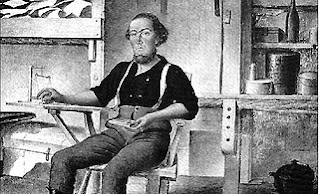Trading: American Fur Company
Fur traders in the 18th and 19th century, as well as the scouts, guides, trappers and Native hunters who worked for them, had a ready demand for their furs. Europe had been the primary consumer of North American fur, primarily beaver pelts and later deerskin hides. Trading companies like the Hudson's Bay Company, the North West Company and smaller firms such as Panton & Leslie held the lion's share of the fur trade. However, these were British firms and as Britain continued to stifle American trade with Europe in the windup to the War of 1812, Americans found their own firms and looked to other markets. China became a viable customer for American furs, beaver and later buffalo robes. An enterprising German immigrant named John Jacob Astor seized on this opportunity and created the American Fur Company in 1808.
The American Fur Company worked in a similar way as Hudson's and other similar firms. Cheaply manufactured trade goods would be made available at trading posts. Natives could bring pelts to trade, or itinerant trappers, working in the wilderness for months at a time, could bring the furs to trading posts or to yearly gatherings known as rendezvous and trade for money, liquor and supplies. Astor's company established its first factories, as trading posts were known then, connected to more distant trading posts out west. With the support of then-President Thomas Jefferson and other leaders such as the Mayor of New York, furs transitioned from posts as far as the Pacific ocean, to eastern American ports and were on their way to China, all on ships owned by Astor. Once in China, the furs could be traded for luxury goods such as tea and porcelain, bypassing embargoes by Britain and Napoleonic France alike.
Astor's company left an indelible mark on the American landscape. Much of the eastern fur trade, particularly along the Great Lakes, was still controlled by Hudson's Bay and the American Fur Company found stiff competition from them and from lucrative independents, such as Manuel Lisa's trading company. However, further and further west, AFC and its affiliates were able to make inroads into Hudson's profits, shaping the American west as they did so. Towns such as Fort Laramie, Wyoming, Fort Benton, Montana and Astoria, Oregon began as AFC trading posts. Mountain men wo worked for the company later traded on the skills as guides and scouts for military exploration of the American west, as well as interpreters for the various Native tribes. All good things had to come to end. As silk, cotton and other textiles replaced fur, the demand died out. Astor withdrew his investment in 1834 and continued investing in real estate, becoming one of the wealthiest men in America. The AFC gradually broke up. By 1847, it was defunct and no longer operating.
This post also appears in https://greatwarriorspath.blogspot.com, which traces the history of Native, tribes and leaders east of the Mississippi in the days of the colonial frontier.
The American Fur Company worked in a similar way as Hudson's and other similar firms. Cheaply manufactured trade goods would be made available at trading posts. Natives could bring pelts to trade, or itinerant trappers, working in the wilderness for months at a time, could bring the furs to trading posts or to yearly gatherings known as rendezvous and trade for money, liquor and supplies. Astor's company established its first factories, as trading posts were known then, connected to more distant trading posts out west. With the support of then-President Thomas Jefferson and other leaders such as the Mayor of New York, furs transitioned from posts as far as the Pacific ocean, to eastern American ports and were on their way to China, all on ships owned by Astor. Once in China, the furs could be traded for luxury goods such as tea and porcelain, bypassing embargoes by Britain and Napoleonic France alike.
Astor's company left an indelible mark on the American landscape. Much of the eastern fur trade, particularly along the Great Lakes, was still controlled by Hudson's Bay and the American Fur Company found stiff competition from them and from lucrative independents, such as Manuel Lisa's trading company. However, further and further west, AFC and its affiliates were able to make inroads into Hudson's profits, shaping the American west as they did so. Towns such as Fort Laramie, Wyoming, Fort Benton, Montana and Astoria, Oregon began as AFC trading posts. Mountain men wo worked for the company later traded on the skills as guides and scouts for military exploration of the American west, as well as interpreters for the various Native tribes. All good things had to come to end. As silk, cotton and other textiles replaced fur, the demand died out. Astor withdrew his investment in 1834 and continued investing in real estate, becoming one of the wealthiest men in America. The AFC gradually broke up. By 1847, it was defunct and no longer operating.
This post also appears in https://greatwarriorspath.blogspot.com, which traces the history of Native, tribes and leaders east of the Mississippi in the days of the colonial frontier.




Comments
Post a Comment